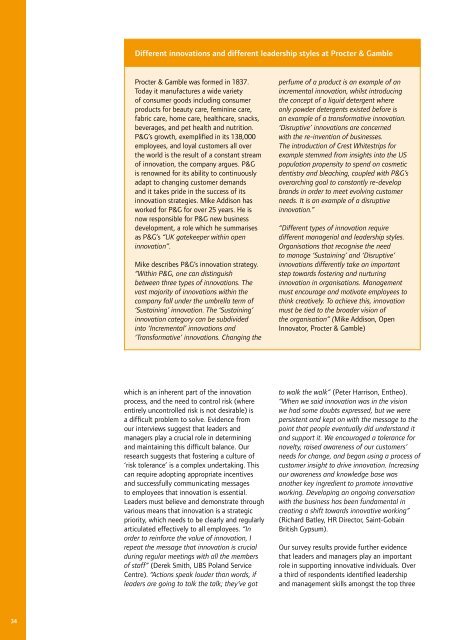Everyday innovation report - Nesta
Everyday innovation report - Nesta
Everyday innovation report - Nesta
Create successful ePaper yourself
Turn your PDF publications into a flip-book with our unique Google optimized e-Paper software.
34<br />
Different <strong>innovation</strong>s and different leadership styles at Procter & Gamble<br />
Procter & Gamble was formed in 1837.<br />
Today it manufactures a wide variety<br />
of consumer goods including consumer<br />
products for beauty care, feminine care,<br />
fabric care, home care, healthcare, snacks,<br />
beverages, and pet health and nutrition.<br />
P&G’s growth, exemplified in its 138,000<br />
employees, and loyal customers all over<br />
the world is the result of a constant stream<br />
of <strong>innovation</strong>, the company argues. P&G<br />
is renowned for its ability to continuously<br />
adapt to changing customer demands<br />
and it takes pride in the success of its<br />
<strong>innovation</strong> strategies. Mike Addison has<br />
worked for P&G for over 25 years. He is<br />
now responsible for P&G new business<br />
development, a role which he summarises<br />
as P&G’s “UK gatekeeper within open<br />
<strong>innovation</strong>”.<br />
Mike describes P&G’s <strong>innovation</strong> strategy.<br />
“Within P&G, one can distinguish<br />
between three types of <strong>innovation</strong>s. The<br />
vast majority of <strong>innovation</strong>s within the<br />
company fall under the umbrella term of<br />
‘Sustaining’ <strong>innovation</strong>. The ‘Sustaining’<br />
<strong>innovation</strong> category can be subdivided<br />
into ‘Incremental’ <strong>innovation</strong>s and<br />
‘Transformative’ <strong>innovation</strong>s. Changing the<br />
which is an inherent part of the <strong>innovation</strong><br />
process, and the need to control risk (where<br />
entirely uncontrolled risk is not desirable) is<br />
a difficult problem to solve. Evidence from<br />
our interviews suggest that leaders and<br />
managers play a crucial role in determining<br />
and maintaining this difficult balance. Our<br />
research suggests that fostering a culture of<br />
‘risk tolerance’ is a complex undertaking. This<br />
can require adopting appropriate incentives<br />
and successfully communicating messages<br />
to employees that <strong>innovation</strong> is essential.<br />
Leaders must believe and demonstrate through<br />
various means that <strong>innovation</strong> is a strategic<br />
priority, which needs to be clearly and regularly<br />
articulated effectively to all employees. “In<br />
order to reinforce the value of <strong>innovation</strong>, I<br />
repeat the message that <strong>innovation</strong> is crucial<br />
during regular meetings with all the members<br />
of staff” (Derek Smith, UBS Poland Service<br />
Centre). “Actions speak louder than words, if<br />
leaders are going to talk the talk; they’ve got<br />
perfume of a product is an example of an<br />
incremental <strong>innovation</strong>, whilst introducing<br />
the concept of a liquid detergent where<br />
only powder detergents existed before is<br />
an example of a transformative <strong>innovation</strong>.<br />
‘Disruptive’ <strong>innovation</strong>s are concerned<br />
with the re-invention of businesses.<br />
The introduction of Crest Whitestrips for<br />
example stemmed from insights into the US<br />
population propensity to spend on cosmetic<br />
dentistry and bleaching, coupled with P&G’s<br />
overarching goal to constantly re-develop<br />
brands in order to meet evolving customer<br />
needs. It is an example of a disruptive<br />
<strong>innovation</strong>.”<br />
“Different types of <strong>innovation</strong> require<br />
different managerial and leadership styles.<br />
Organisations that recognise the need<br />
to manage ‘Sustaining’ and ‘Disruptive’<br />
<strong>innovation</strong>s differently take an important<br />
step towards fostering and nurturing<br />
<strong>innovation</strong> in organisations. Management<br />
must encourage and motivate employees to<br />
think creatively. To achieve this, <strong>innovation</strong><br />
must be tied to the broader vision of<br />
the organisation” (Mike Addison, Open<br />
Innovator, Procter & Gamble)<br />
to walk the walk” (Peter Harrison, Entheo).<br />
“When we said <strong>innovation</strong> was in the vision<br />
we had some doubts expressed, but we were<br />
persistent and kept on with the message to the<br />
point that people eventually did understand it<br />
and support it. We encouraged a tolerance for<br />
novelty, raised awareness of our customers’<br />
needs for change, and began using a process of<br />
customer insight to drive <strong>innovation</strong>. Increasing<br />
our awareness and knowledge base was<br />
another key ingredient to promote innovative<br />
working. Developing an ongoing conversation<br />
with the business has been fundamental in<br />
creating a shift towards innovative working”<br />
(Richard Batley, HR Director, Saint-Gobain<br />
British Gypsum).<br />
Our survey results provide further evidence<br />
that leaders and managers play an important<br />
role in supporting innovative individuals. Over<br />
a third of respondents identified leadership<br />
and management skills amongst the top three







